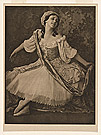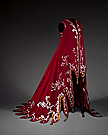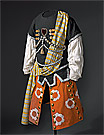Le Pavillon d'Armide [Armida's Pavillion]
Ballet in one act
- Producer: Les Ballets Russes de Serge Diaghilev
- First performed: 25 November 1907, Mariinsky Theatre, St Petersburg
- Paris premiere: 19 May 1909, Théâtre du Châtelet, Paris
- Costume design: Alexandre Benois
- Costumier: Ivan Caffi (Imperial Theatres, St Petersburg)
- Scenery design: Alexandre Benois
- Music: Nicholas Tcherepnin
- Choreography: Michel Fokine
- Libretto: Alexandre Benois, after Théophile Gautier’s story Omphale
- Main characters: Armide (Armida), Vicomte (Viscount) René de Beaugency, Armida’s favourite slave, Marquis de Fierbois, King Hidraot, Confidantes of Armide, Vicomte René’s servant Baptiste, Master of Ceremony1
The ballet is set during the reign of Louis XIV (1643–1715). During a storm, the young Vicomte René de Beaugency seeks refuge in a castle owned by an old magician, the Marquis de Fierbois. René spends the night in Armide’s Pavilion, a wing of the castle, where he becomes mesmerised by a Gobelins tapestry hanging on the wall. While asleep he dreams that the tapestry figures of the sorceress Armide and her entourage come to life and perform a series of dances. Encouraged by King Hidraot, a member of Armide’s animated court (and bearing a striking resemblance to the Marquis de Fierbois), René falls in love with Armide, who gives him her scarf as a token in return. Awakening, René discovers that he possesses Armide’s scarf and that her woven tapestry figure does not. Shocked that his reverie was real, he collapses at the feet of the Marquis.
Benois’s interpretation of Gautier’s 1834 short story, Omphale, was influenced by the eighteenth-century Regency and Rococo costumes by the Paris Opéra designers, Jean Bérain (1640–1711) and Louis-René Boquet (1717–1814). Benois drew upon his deep love and knowledge of eighteenth-century French art, evoking the Rococo style’s light elegance and design unity in this first Ballets Russes production. The leitmotif of the story’s animated Gobelins tapestry is expanded to dominate the stage, with the costumes’ painted silver patterns and metallic braids and fringes designed to catch the light as the performers, animated from their woven state, appeared to weave in and out of the overall decoration. This play of reality, memory and illusion also revealed Benois’ interest in the dreamlike quality and supernatural subject matter in the work of the German Romantic composer and writer, E T A Hoffmann.





